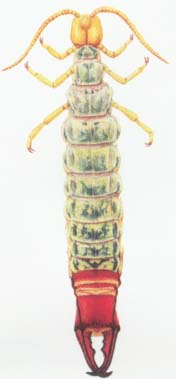The antennae are in the shape of beads and have built-in chewing mouthparts; there are no compound eyes or single eyes. The body length is 2-20 mm. There is a kind of worm in Tibet, my country, with a body length of 49 mm, which is rare in the world. Body white or yellow. The forechest is small, and the middle and hind chest are similar. The tarsal segment is 1 segment and has 2-3 claws. The abdomen has 11 segments, and the first 7 segments have paired spikes and vesicles. The tail whiskers are well developed, among which the species with linear tail whiskers are called dipterids; the species with tail whiskers ossified into pincer-like shapes are called trichocereus (pictured by Chen Ruijin). This order is sometimes promoted to the class Dipeta.

There are about 600 known species in the world, and nearly 40 species have been recorded in my country. Insects of this order live in soil at different depths, or in moist places, under rocks, rotten wood, dead tree bark, or fallen leaves. It is afraid of light and feeds on humus, fungi or tiny animals.
The characteristics of this order can be summarized as follows: eyeless and bicaudal, with tentacles like rosary beads; tail whiskers or tail hairpins with one or seven vesicular spines.
animal tags: Insects Dicera Triceratops
We created this article in conjunction with AI technology, then made sure it was fact-checked and edited by a Animals Top editor.